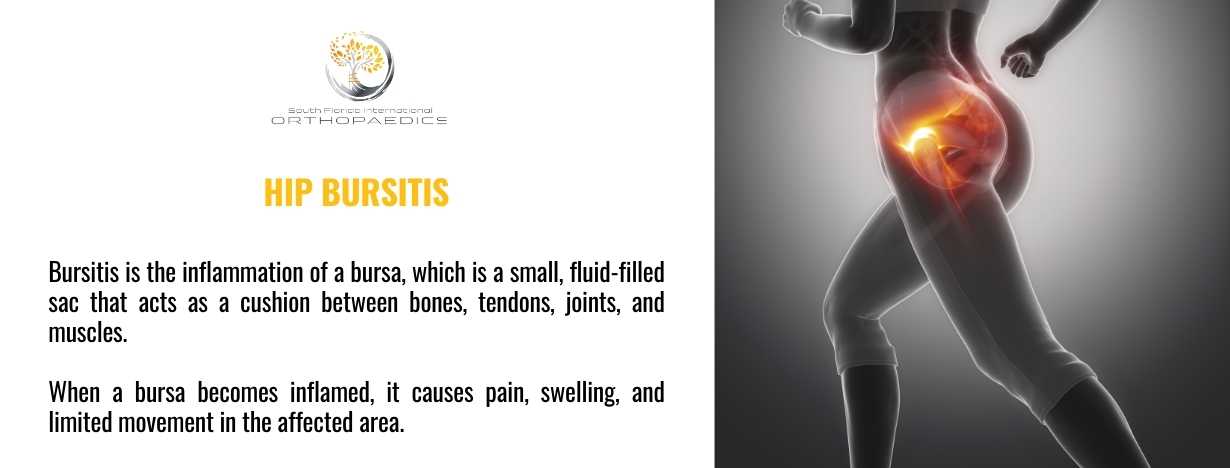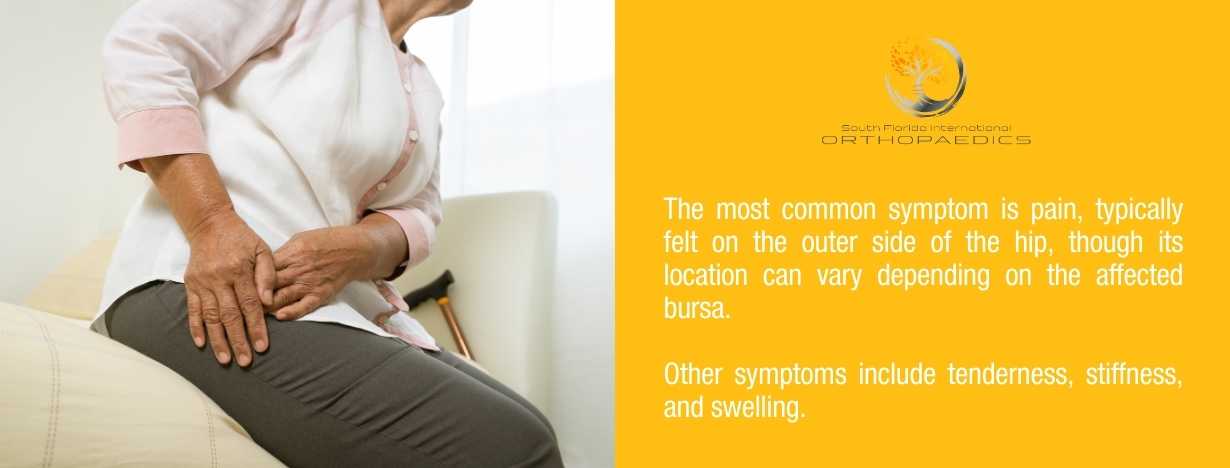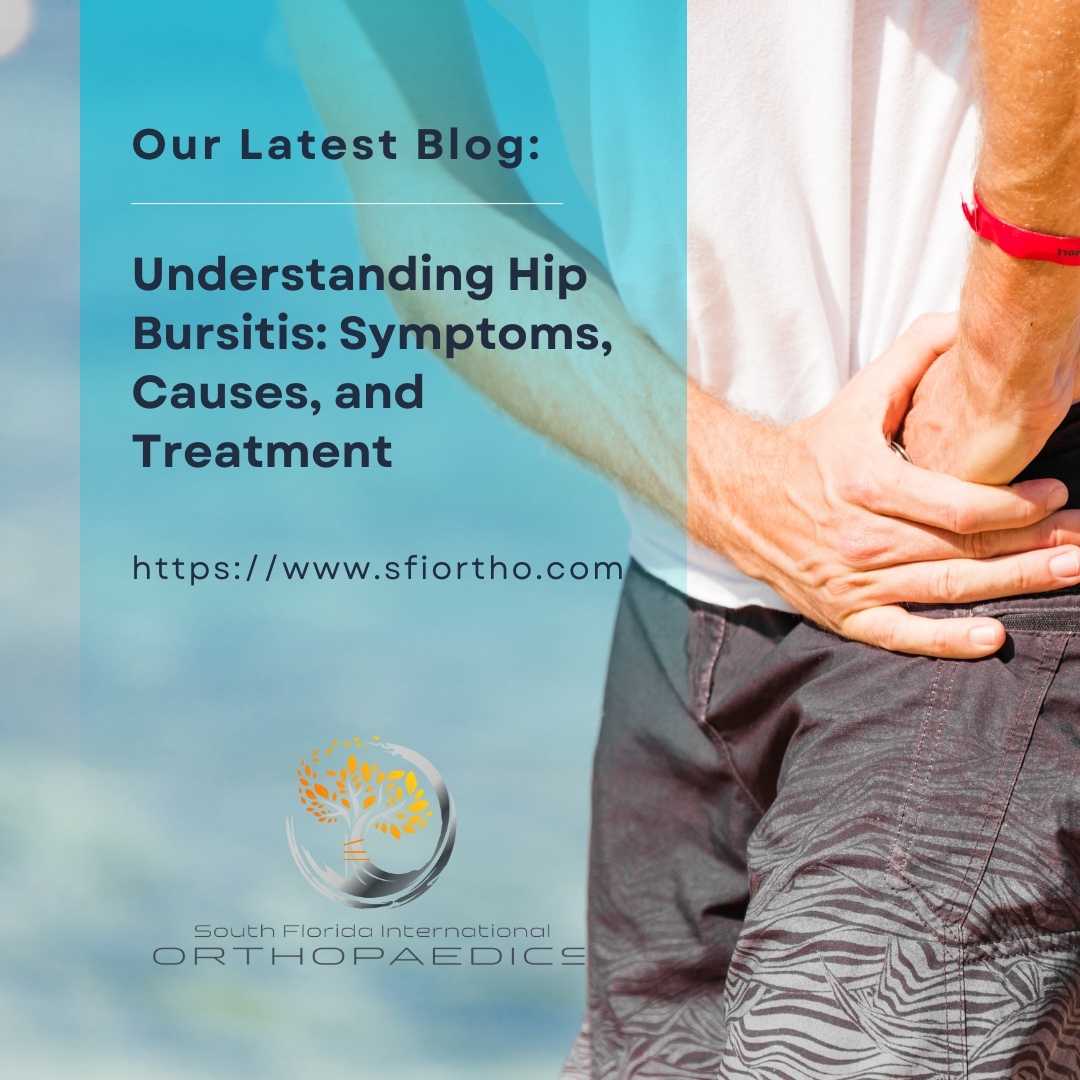Have you ever woken up with a sharp pain in your hip, making it difficult to get out of bed? Or maybe that dull ache has been nagging you for weeks, hindering your favorite activities.
If so, you might be dealing with hip bursitis. This common condition affects millions of people each year, causing discomfort and limiting mobility.

Read on below to learn more about the symptoms, causes, and treatment options for hip bursitis. By understanding this condition, you can take control of your recovery and get back to enjoying an active life.
What is hip bursitis?
The hip joint is a complex structure that allows for a wide range of motion. However, constant movement can sometimes irritate specific tissues in the area, such as the bursa.
The bursae are small, fluid-filled sacs that act as tiny cushions. They are positioned strategically between bones, tendons, muscles, and skin and reduce friction during movement, ensuring the smooth gliding of these structures.
Your hips have several bursae, but the two most commonly affected by inflammation are:
- Trochanteric bursa: The greater trochanter is located on the outer bony prominence of your hip. This bursa protects the area from friction caused by muscles and tendons rubbing against the bone during movement.
- Iliac psoas bursa: Situated in the front of your hip joint, near the groin. This bursa cushions the underlying iliopsoas muscle, which helps with hip flexion.
When a bursa becomes inflamed, it causes pain, swelling, and limited movement in the affected area. This then leads to the development of hip bursitis.
What causes hip bursitis?
Hip bursitis can arise from various factors that irritate the bursae. Here are some of the most common culprits:
Overuse
Repetitive activities that put stress on the hip joint, particularly those involving forceful hip flexion or extension, can irritate the bursae. Runners, cyclists, and athletes participating in sports like soccer or basketball are more susceptible.
Improper technique
Engaging in activities with poor form or technique can place undue stress on the hip joint, increasing the risk of bursitis.
Direct injury
A fall or blow to the hip can directly injure the bursa, leading to inflammation.
Muscle imbalances
Weak or imbalanced muscles around the hip joint can lead to improper mechanics and increased stress on the bursae. Strengthening these muscles can help prevent future issues.
Posture
Poor posture, such as excessive sitting or standing with one hip hiked higher than the other, can put undue strain on the hip joint and contribute to bursitis.
Medical conditions
Certain medical conditions, like rheumatoid arthritis or gout, can also cause inflammation of the bursae, including those in the hip.
What are the symptoms of hip bursitis?
The most common symptom is pain, typically felt on the outer side of the hip, though its location can vary depending on the affected bursa. Other symptoms include the following:
- Tenderness
- Stiffness
- Pain that worsens with activity.

While the symptoms mentioned above are suggestive, it’s crucial to differentiate hip bursitis from other conditions that cause hip pain. Consulting a healthcare professional for proper diagnosis is essential to ensure you receive the right treatment.
What are the treatment options for hip bursitis?
An orthopedic specialist can diagnose the condition through a physical examination, X-rays, or other imaging tests if needed.
Doctors usually recommend non-surgical treatment options for mild cases of hip bursitis and surgery for severe ones. Here’s an overview of the most common approaches:
Rest
Reduce activities that aggravate the pain. While complete immobilization isn’t necessary, avoid strenuous activities, repetitive movements, and prolonged sitting. Opt for low-impact activities like swimming or gentle walking.
RICE therapy
This acronym stands for Rest, Ice, Compression, and Elevation. Apply ice packs wrapped in a towel to the affected area for 15-20 minutes several times daily. Avoid direct application of ice to the skin.
Compression with a bandage can help minimize swelling, but it should not be too tight. Elevate your hip above your heart when resting to reduce inflammation.
Pain medications
Over-the-counter medications like ibuprofen or naproxen can help manage pain and inflammation. In some cases, your doctor may prescribe stronger medications like corticosteroids to reduce inflammation more effectively.
Physical therapy
Physical therapy plays a vital role in managing hip bursitis. A physical therapist will design a personalized exercise program focusing on strengthening the muscles around the hip joint, improving flexibility, and correcting posture imbalances.
Corticosteroid injection
If other treatments prove ineffective, a doctor might recommend a corticosteroid injection directly into the inflamed bursa. This can provide targeted relief and reduce inflammation quickly.
Surgery
Surgery is rarely necessary for hip bursitis. However, in severe cases where inflammation persists despite conservative treatment and the bursa is significantly damaged, your doctor might recommend surgical removal of the affected bursa. This is typically an outpatient procedure with a short recovery time.
Don’t Let Hip Bursitis Slow You Down: Get Expert Solutions at South Florida International Orthopaedics
Hip bursitis can be a frustrating and painful condition, limiting your mobility and hindering your daily activities.

At South Florida International Orthopaedics, we understand the impact this condition can have on your life. That’s why we offer comprehensive, personalized treatment plans to help you manage your hip bursitis effectively and get back to living an active life.
Beyond bursitis, our team also specializes in treating various musculoskeletal conditions that affect the hip using state-of-the-art treatment procedures, such as:
Contact our South Florida orthopedics team today to schedule an appointment and take the first step toward recovery.
The material contained on this site is for informational purposes only and DOES NOT CONSTITUTE THE PROVIDING OF MEDICAL ADVICE, and is not intended to be a substitute for independent professional medical judgment, advice, diagnosis, or treatment. Always seek the advice of your physician or other qualified healthcare providers with any questions or concerns you may have regarding your health.
